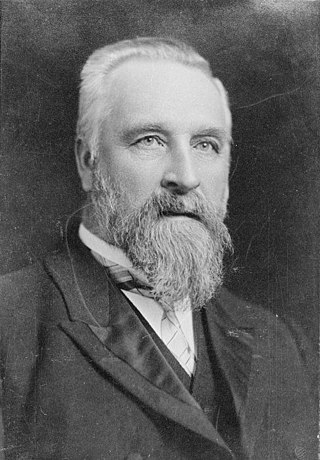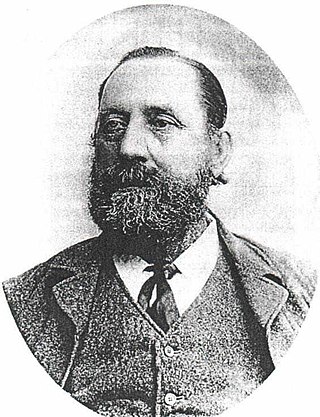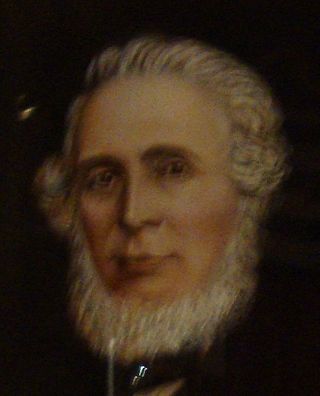Related Research Articles

Motueka is a town in the South Island of New Zealand, close to the mouth of the Motueka River on the western shore of Tasman Bay. It is the second largest in the Tasman Region, with a population of 8,320 as of June 2023.
Alfred Christopher Picard was a 19th-century New Zealand politician.
The 2nd New Zealand Parliament was a term of the Parliament of New Zealand. It opened on 15 April 1856, following New Zealand's 1855 election. It was dissolved on 5 November 1860 in preparation for 1860–61 election. The 2nd Parliament was the first under which New Zealand had responsible government, meaning that unlike previously, the Cabinet was chosen by Parliament rather than by the Governor-General of New Zealand.
Charles Parker was a New Zealand politician and a carpenter.

The 1896 New Zealand general election was held on Wednesday, 4 December in the general electorates, and on Thursday, 19 December in the Māori electorates to elect a total of 74 MPs to the 13th session of the New Zealand Parliament. A total number of 337,024 (76.1%) voters turned out to vote.

Nelson Province was constituted in 1853 under the New Zealand Constitution Act 1852, and originally covered the entire upper South Island, including all of present-day Buller, Kaikoura, Marlborough, and Tasman districts, along with Nelson City, Grey District north of the Grey River, and the Hurunui District north of the Hurunui River. It was reduced in size by the creation of Marlborough Province in November 1859, then abolished in 1876, along with all the provinces of New Zealand.
Samuel Stephens was a 19th-century surveyor and New Zealand politician.

Roderick McKenzie was a New Zealand Member of Parliament for Buller and Motueka, in the South Island. He was a member of the Liberal Party.
Motueka and Massacre Bay was one of the original parliamentary electorates created for the 1st New Zealand Parliament. It existed from 1853 to 1860 and was represented by three Members of Parliament. In the 1860 electoral redistribution, the area was split in half, and the Motueka and Collingwood electorates were created from it.
Motueka is a former New Zealand parliamentary electorate. It was first created in 1860 and existed until the 1890 election, when it was abolished. For the 1896 election the Motueka electorate was recreated, and lasted until the 1946 election, when it was again abolished.
Grey and Bell was a Taranaki electorate in the New Zealand Parliament from 1853 to 1881.

Richard Phineas Hudson was a Reform Party Member of Parliament in New Zealand. Born in Ireland, he was a tea planter in British Ceylon before becoming a fruit grower in New Zealand.
Waimea-Sounds was a fully rural parliamentary electorate in the Marlborough and Nelson Regions of New Zealand, from 1893 to 1896. During its one parliamentary term of existence, the Waimea-Sounds electorate was represented by one Member of Parliament.
Waimea-Picton was a parliamentary electorate in the Marlborough and Nelson Regions of New Zealand, from 1887 to 1893.
Collingwood was a parliamentary electorate in what is now the Tasman region of the South Island of New Zealand from 1861 to 1881.

Richmond Hursthouse was a 19th-century Member of Parliament in Nelson, New Zealand, and a cabinet minister.
Herbert Evelyn Curtis (1818–1890) was a 19th-century Member of Parliament in Nelson, New Zealand.

John Kerr was a 19th-century Member of Parliament from Nelson, New Zealand. As well as Lake Station, Kerr also owned the 70,000 acres (28,000 ha) Tarndale Run and 30,000 acres (12,000 ha) around the Wairau River before entering into a business partnership with Molesworth Station owner Acton Adams. Kerr commissioned cob builder Ned James to build Tarndale homestead in 1874.

John Perry Robinson was the second Superintendent of the Nelson Province in New Zealand. His election came as a surprise, but he proved so popular that he won two subsequent elections with comfortable majorities. He remained Superintendent until his accidental drowning on the bar of the Buller River.

The 1853 New Zealand provincial elections were the first elections in New Zealand to elect members and superintendents to the newly created Provinces of New Zealand. The elections were held between July and September 1853, at the same time as the 1853 New Zealand general elections for the central government, which were held between July and October. The provincial elections had higher voter turnouts than the general elections, with the elections for provincial superintendents having the highest voter turnout.
References
- ↑ Wilson, James Oakley (1985) [First ed. published 1913]. New Zealand Parliamentary Record, 1840–1984 (4th ed.). Wellington: V.R. Ward, Govt. Printer. p. 225. OCLC 154283103.
- ↑ Te ara NZ encyclopedia
- ↑ "Local Intelligence". Nelson Examiner and New Zealand Chronicle. 21 May 1856. p. 2. Retrieved 1 May 2013.